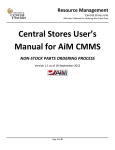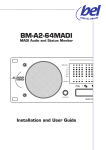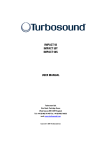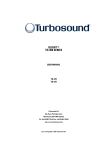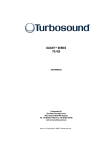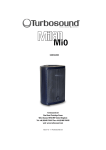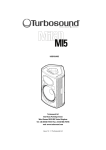Download Turbosound LMS-D4 User's Manual
Transcript
LMS-D4 DIGITAL LOUDSPEAKER MANAGEMENT SYSTEM USER MANUAL Turbosound Ltd. Star Road, Partridge Green West Sussex RH13 8RY England Tel: +44 (0)1403 711447 Fax: +44 (0)1403 710155 web: www.turbosound.com user manual LMS-D4 CONTENTS Important Safety Information ............................................................................................................3 Unpacking the LMS-D4 ......................................................................................................................4 Introduction ........................................................................................................................................5 Features ............................................................................................................................................. 5 Front Panel Functions ........................................................................................................................6 Rear Panel Functions..........................................................................................................................7 Output Configurations .......................................................................................................................8 Operating the LMS-D4 .......................................................................................................................9 Crossover Settings ........................................................................................................................... 11 Specifications ................................................................................................................................... 15 Warranty ........................................................................................................................................... 16 Appendix A ....................................................................................................................................... 17 LMS-D4 user manual Page 2 user manual LMS-D4 An example of this equipment has been tested and found to comply with the following European and international Standards for Electromagnetic Compatibility and Electrical Safety: Conducted and Absorbed Emissions (EU): EN55103 (1996) Harmonic Current Emisions (EU): EN61000-3-2 Voltage Fluctuations/Flicker (EU): EN61000-3-3 Generic Immunity (EU): EN50082-1 (1997) Electrical Safety (EU): EN60065 (1998) Electrical Safety (US): UL6500 (2000) Electrical Safety (Canada): CSA E6500 (1999) Important Safety Information Please read carefully and keep the following instructions and safety information. Heed all warnings and follow all instructions. • Do not remove covers. There are no user serviceable parts inside, please refer servicing to qualified service personnel. This equipment must be earthed. • Protect the power cord from being walked on or pinched particularly at plugs, convenience receptacles, and the point where they exit from the apparatus. • Only use attachments/accessories specified by the manufacturer. • Servicing is required when the apparatus has been damaged in any way, such as the power supply cord or plug is damaged, liquid has been spilled or objects have fallen into the apparatus, the apparatus has been exposed to rain or moisture, does not operate normally, or has been dropped. CAUTION RISK OF ELECTRIC SHOCK DO NOT OPEN DO NOT EXPOSE TO RAIN OR MOISTURE ATTENTION RISQUE DE CHOC ELECTRIQUE NE PAS ENLEVER NE PAS EXPOSER A LA PLUIE NI A L’HUMIDITE LMS-D4 user manual Page 3 user manual LMS-D4 Thanks Thank you for choosing the TURBOSOUND LMS-D4 for your application. Please spare a little time to study the contents of this manual, so that you obtain the best possible performance from this unit. All TURBOSOUND products are carefully engineered for world class performance and reliability. If you would like further information about this or any other TURBOSOUND product, please contact us. We look forward to helping you in the near future. Unpacking the LMS-D4 After unpacking the unit please check carefully for damage. If damage is found, please notify the carrier concerned at once. You, the consignee, must instigate any claim. Please retain all packaging in case of future re-shipment. LMS-D4 user manual Page 4 user manual LMS-D4 Introduction The LMS-D4 is a compact and powerful DSP based audio-processing unit designed for use with particular Turbosound loudspeaker systems and associated bass enclosures, combining the functions of multiple conventional products in a compact 1U high 19” rack unit. To achieve this the LMS-D4 has 2 inputs and 4 outputs, which are configured by different system presets to allow two basic modes: stereo 2 way and mono 3 way. The unit is designed to provide specific equalisation and crossover points aimed at optimising the performance of these Turbosound loudspeaker systems. In addition, limiters, delays (up to the equivalent of 14 metres), gain, polarity, and bass trim controls are accessible to the user in order to match specific operation environments. The LMS-D4 is designed for quick setup and adjustment via easy-to-use front panel controls. Features • The LMS-D4 provides exceptional exceptional audio quality with carefully optimised processing and high performance converters for a full >108dB dynamic range, high sampling rate and minimal filtering. Audio-grade capacitors are used in the analogue signal path. • Bass boost filter, filter allowing an easy adjustment of the response to match variations in acoustic environment such as half space operation (for floor monitor use), coupling of cabinets in arrays, or room resonances. • Front panel rotary encoder providing a familiar and easy to use control format with all filter information displayed simultaneously on a backlit LCD display. • Delay of up to 42mS can be set for each output (mono) or each pair of outputs (stereo). LMS-D4 user manual Page 5 user manual LMS-D4 Front Panel Functions 3 LMS-D4 2 < BACK NEXT > MENU ENTER 6 SCROLL 8 A B 1 2 3 4 CLIP LIMIT -24 1 RS-232 MUTE DIGITAL LOUDSPEAKER MANAGEMENT SYSTEM 4 5 7 9 10 1. LCD Display - Shows menu options, output information and the parameters being adjusted. 2. Menu Key - Activates the main menu on the LCD display, and toggles between menu options and system name display. Different menus are selected by pressing the ‘BACK’ and ‘NEXT’ keys. 3. Next Key - Moves forwards through the list of available menus or options 4. Back Key - Moves backwards through the list of available menus or options. 5. Enter Key - Enters the chosen menu and confirms menu selections. 6. Scroll knob - The rotary encoder allows the current parameter displayed on the LCD screen to be adjusted, and scrolls through the available list of presets. 7. Input LED’s - The bottom green LED indicates when the input signal is at -24dBu, whereas the top red LED indicates overload of the analogue to digital converter. 8. Limiters LED’s – Indicates when limiting occurs on a particular output channel. The red LED is set at the limiter threshold for that channel, provided limiter and gain settings are correct. 9. Mute Key – This mute key is active on all four output channels simultaneously. The red LED is illuminuted when the channels are muted. 10. RS232 input – The 9-pin socket allows communication with a PC via a serial COM port and a standard RS232 cable. LMS-D4 user manual Page 6 user manual LMS-D4 Rear Panel Functions 1 LMS-D4 SERIAL NO.: STAR ROAD, PARTRIDGE GREEN, WEST SUSSEX, RH13 8RY THIS APPARATUS MUST BE EARTHED. DO NOT EXPOSE THIS UNIT TO MOISTURE. DO NOT REMOVE THIS COVER. NO USER SERVICEABLE PARTS INSIDE. REPLACE FUSE WITH SAME TYPE ONLY. MADE INTHE E.U. OUTPUT 3 OUTPUT 2 OUTPUT 1 RIGHT / MONO IN LEFT IN PIN1=SHIELD PIN2=HOT PIN3=COLD POWER ~ 50/60Hz 100V-240V Fuse Sticker 2 1. OUTPUT 4 4 3 Mains Power - Connected via a standard IEC socket. A compatible power cord is supplied with the unit. 2. Mains Fuse - Located in a finger-proof fuseholder integral to the mains inlet. Always replace this fuse with the correct type as shown on the rear panel legend. (N.B. A spare fuse is located in this holder.) 3. Audio Inputs - 3 pin female XLR connectors are provided for each audio input. All terminations are electronically balanced, pin 2 Hot, pin 3 Cold and pin 1 Screen (shield). The input sensitivity is pre-set at 0db. The overall default gain of the unit is set at -14dB. Please note that when the unit is operated in mono 3-way mode, the input signal is to be fed into the RIGHT / MONO connector. 4. Audio Outputs - 3 pin male XLR connectors are provided for each audio output. All terminations are electronically balanced, pin 2 Hot, pin 3 Cold and pin 1 Screen (shield). Please note that connecting to unbalanced amplifier inputs should be avoided as it will result in a 6 dB loss of level, and limiters settings will be out by 6 dB. LMS-D4 user manual Page 7 user manual LMS-D4 Outputs are configured as follows:follows:System O/P 1 O/P 2 O/P 3 O/P 4 TQTQ-308 Passive - Left - Right TQTQ-308 Pas + Sub Left Sub Left Main Right Sub Left Main TQTQ-310 Passive - Left - Right TQTQ-310 Pas + Sub Left Sub Left Main Right Sub Left Main TQTQ-310 Pas. Monitor - Left - Right TQTQ-315 Passive - Left - Right TQTQ-315 Pas + Sub Left Sub Left Main Right Sub Left Main TQTQ-315 Pas. Monitor - Left - Right TQTQ-315 Biamp Left LF Left HF Right LF Right HF TQTQ-315 Biamp + Sub - Sub Low High TQTQ-315 Biamp Mon. Left LF Left HF Right LF Right HF TQTQ-440 Left LF Left HF Right LF Right HF TQTQ-440 + TQTQ-425 - Sub Low High TFMTFM-420 Left LF Left HF Right LF Right HF TFMTFM-450 Left LF Left HF Right LF Right HF THLTHL-2 Left LF Left HF Right LF Right HF THLTHL-2 + THLTHL-828 - Sub Low High THLTHL-811 + THLTHL-828 Left Sub Left Main Right Sub Right Main TQTQ-200 Series Left Sub Left Main Right Sub Right Main TCS Series Left Sub Left Main Right Sub Right Main TXD Series Left Sub Left Main Right Sub Right Main Mono Flat Ch A Ch B Ch C Ch D Stereo Flat Ch A Left Ch B Left Ch A Right Ch B Right LMS-D4 user manual Page 8 user manual LMS-D4 Operating the LMS-D4 With the unit mounted in a rack or cabinet, securely plug in all connections and check especially that the Low (LF or Bass) and High (HF or Top) outputs are connected to the correct amplifiers. It is good practice to switch on the LMS-D4 before powering up the amplifiers. When you plug the LMS-D4 into the mains power supply, the unit will power up and the LCD display indicates the last system loaded; the unit will be configured as it was when it was last turned off. The current software version is also displayed for 10 seconds at start-up. The red Mute LED will also be illuminated, as the unit powers up by default with all outputs muted. Menu Structure The structure includes three sub-menus: Load a Xover, Xover Xover Setup and Utilities. Utilities Their operation is described in the next paragraphs. To access menus, press the ‘MENU’ key and then use ‘BACK’ and ‘NEXT’ to navigate. Finally press ‘ENTER’ when the desired sub-menu appears on the display. System Selection This menu allows the selection of a particular loudspeaker system and configures the LMS-D4 accordingly. It sets equalisation, crossovers, and other parameters to optimal default values and the factory presets. To display and go through the available systems, use the ‘SCROLL’ rotary encoder. The system names will appear on the bottom line of the display. Once the desired configuration appears, confirm the selection by pressing ‘ENTER’. Please note that this will cause the outputs to be automatically muted; this is to limit accidental change that could endanger the loudspeaker components.. After a system is loaded the limiter settings must be adjusted since the default OFF’’. setting is ‘OFF Xover Setup This menu allows you to change the settings of a number of parameters, also refered to as “user controls”. They are detailed in the next section.. Having entered the ‘Xover Setup’ menu, the information displayed will generally include three fields: 1) The top row:- the output channel(s) being refered to. 2) At the left hand side of the bottom row:- the name of the parameter being edited. 3) At the right hand side of the bottom row:- the value of the parameter. As an exception when the control is not channel related, its description will appear on the top row (e.g. for Bass Boost). LMS-D4 user manual Page 9 user manual LMS-D4 Use the ‘NEXT’ and ‘BACK’ keys to navigate through the accessible user controls. Then when the desired control appears on the display, use the the ‘SCROLL’ button to change the value as displayed on the bottom row. IMPORTANT: Check that the limiter and amplifier settings are correct and that mixer levels are minimised before unmuting the LMS-D4. Utilities This menu gives access to three features as indicated below:Lock/unlock Locking the unit will prevent any change of the system in use as well as editing any of the user controls. To lock the unit, a password of 3 digits has to be entered. Use the ‘NEXT’ and ‘BACK’ keys to move from one digit to the other, and the ‘SCROLL’ button to edit each of the three values. Finally press the ENTER’ key. To unlock the unit, simply follow the same procedure. Clear User Setups This sttores the factory preset (default) values for the system currently selected. As a result any change previously made to the user controls values will be cancelled. Download from PC A standard 9 pin RS-232 type connector is provided to facilitate the future implementation of software downloads and future upgrades. To download new flash memory data this option must be enabled. LMS-D4 user manual Page 10 user manual LMS-D4 CROSSOVER SETTINGS 1) Input Gain INPUT GAIN Gain = 0.0dB The input gain sets the attenuation of the signal before any processing is applied. The value ranges from -40dB to +6dB in 0.5dB steps. In stereo mode the gain value applies to both inputs. 2) LF Bass Boost BASS BOOST Trim = 0.0dB Where implemented, the range of values are from +6.0 dB to –6.0 dB, in 0.5 dB steps. The corner frequency is fixed and optimised for each system, and typically it is around 100Hz. The Bass Boost control allows for an easy adjustment of the response to match variations in the acoustic environment. Generally the 0 dB setting will provide an optimally flat response for a single cabinet in free space. When the cabinet is used in direct proximity of a reflecting surface (i.e. half-space conditions), the LF level should be reduced to maintain the same balance (in theory by 3dB). Similarly when a number of cabinets are closely coupled (e.g. in arrays) the LF control should be used to reduce the level in the bottom end. This control can also be used to create subjectively desired changes to the tonal balance. Please remember to use it with care, as excessive boost could mean more stress for the drive units and make it more critical to have the limiters accurately set. Bass boost is not implemented in settings for speaker systems with subwoofers. LMS-D4 user manual Page 11 user manual LMS-D4 3) Sub-bass channels operation mode OP1+3 Sub Mode = Stereo The possible values are ‘Stereo’ and ‘MonoSum L+R’. With a system using a stereo two way configuration and having channels 1 and 3 dedicated for sub-bass operation, it is possible to set these channels either as independent (i.e. in stereo mode) or with the signals from both Left and Right inputs summed. Note: this screen is not available on monitor programs or bi-amp with sub programs. 4) Peak Limiters OP1+3 Sub Limiter = +5dBu Each output has an independent high performance limiter, with both attack and release times fixed and optimally preset according to the frequency range of the channel it operates on. The values (displayed in dBu), refer to signal level at the outputs of the unit. Follow these steps in order to correctly set limiters for your speaker system: 1. Determine the program power handling of the Turbosound loudspeaker (or HF/LF section as appropriate), or from the engineering data sheet or user manual for that product, or from the label on the rear of the cabinet. 2. Calculate the required limiter voltage using the formula: V = √PR where V is the limiter voltage setting, and P is the program power rating of the loudspeaker, and R is the nominal impedance of the loudspeaker LMS-D4 user manual Page 12 user manual LMS-D4 3. Scroll to set the nearest lower voltage to the calculated value in the limiter screen for that loudspeaker model (or frequency band as appropriate), and press ENTER. Refer to the limiter voltage lookup table in Appendix A for a range of approximate conversion values. In addition to those values, the limiters can also be defeated (OFF displayed on the screen). Please note that this setting should be used only if the amplifiers already have internal limiters or soft clipping circuitry. 5) Channel Gain OP1+3 Sub Gain = 4.0 dB Set the gain of the specified output channel relative to the other channel(s). Available values are from +6.0 to –19.4 dB, in 0.2 dB steps. Note: with limiters and amplifier gain set correctly, 0dB relative gain will give maximum output. 6) Polarity OP1+3 Sub Polarity = Normal Define the polarity of the specified output channel. The value can be normal or inverted. 7) Delay OP1+3 Sub Delay = 0.000 ms LMS-D4 user manual Page 13 user manual LMS-D4 Set the signal delay on the specified output channel. The delays can be adjusted in 20.83 uS increments, with a maximum value of 20.7 ms (≡ 7.1 metres) in stereo two way configurations, and 42 ms (≡ 14.4 metres) in mono three way configurations. These delays are provided (their range is large enough) to align the driver components in the time domain – including separate sub-bass cabinets – but will not replace a dedicated delay line unit in applications such as distributed systems. Please also note that, as with other similar digital processing units, the values displayed are relative and do not take into account the basic processing delay of the unit which is approximately 0.4ms. When adjusting the delay on bi-amped loudspeakers it is important to ensure the difference between channels remains fixed so that the HF and LF drivers stay aligned. 8) Store Setup Store Setup The settings of this particular setup can be saved so that when it is next recalled, the user edited value will return to their preferred settings. LMS-D4 user manual Page 14 user manual LMS-D4 Specifications Inputs Two electronically balanced nominally 0db Impedance 10 kOhm Outputs Four electronically balanced nominally 0db Min. Load 600 Ohm Max. Level +19dBu into 2kOhm load Frequency Resp. Resp ±0.5dB 20Hz - 20kHz Dynamic Range 110dB (typ.) 20Hz -20kHz unweighted Distortion < 0.02% @ 1kHz, +18dBu Maximum Delay up to 42 ms (increment 21 µs) Output gain adjustable -15dB to +15dB in 0.5dB steps and mute Bass Boost shelf adjustable ±6dB in 0.5dB steps Limiters threshold adjustable over an equivalent voltage range of 30 dB range, in 0.5dB steps Display 2 x 20 character backlit LCD Input LED Two per input, signal at -24dBu and digital clip Limiters LED One per output Connectors Inputs 3 pin female XLR Outputs 3 pin male XLR Mains 3 pin IEC Power 100 to 240V ±10% @ 50/60Hz Consumption Consumption 6.5 watts. Weight 2.3 kg net (3.5 kg shipping) Size 1.75”(1U) x 19” x 6.4” (44mm x 482mm x 162 mm) excluding connectors Due to continuing product improvement the above specifications are subject to change. LMS-D4 user manual Page 15 user manual LMS-D4 WARRANTY This product is warranted against defects in components and workmanship only, for a period of one year from the date of shipment to the end user. During the warranty period, TURBOSOUND will, at its discretion, either repair or replace products which prove to be defective, provided that the product is returned, shipping prepaid, to an authorised TURBOSOUND service facility. Defects caused by unauthorised modifications, misuse, negligence, act of God or accident, or any use of this product that is not in accordance with the instructions provided by TURBOSOUND, are not covered by this warranty. This warranty is exclusive and no other warranty is expressed or implied. TURBOSOUND is not liable for consequential damages. LMS-D4 user manual Page 16 user manual LMS-D4 Turbosound Ltd Star Road, Partridge Green West Sussex RH13 8RY England Tel:+44 (0)1403 711447 Fax: +44 (0)1403 710155 web: www.turbosound.com LMS-D4 user manual Page 17

















